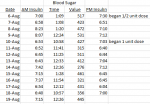That's okay! My vet didn't tell me ANYTHING except my girl needed new food and shots twice a day. Nothing else.

Please don't up the dose to 2 units though! That is way too big a jump for cats. We increase by 0.25 units at a time, with Vetsulin only after a week on a dose and proof that more insulin is needed. We have no information that Milo needs more yet. I'm willing to bet that that high 536 was likely a bounce, meaning more insulin will make it worse.
Bouncing is a phenomenon that occurs when the body experiences (or at least thinks it does) hypoglycemia. Luckily the body uses bouncing as a defense mechanism against this where it attempts to compensate the low blood sugar by dumping excess glucose provided by the liver in an attempt to raise blood sugar back to “normal” numbers. Unfortunately, “normal” is a relative term according to the body. For a diabetic whose body has been untreated for so long that it considered very high numbers to be the new normal, lower numbers can often make the body overreact in attempt to save itself, even if it’s not in danger.
A cat who has been suffering from diabetes for some time may at the point of diagnosis have a new “normal” of 400. When insulin is introduced and brings it down, even to 200 (still diabetic levels), the body thinks it is in danger, dumps excess glucose, and thus the blood sugar skyrockets up to the 400-600s. After enough time has passed, the body will eventually realize that 200 isn’t such a bad number, and bouncing will happen less often. Note some cats are extremely bounce-prone and a switch to Lantus/Levemir is needed.
There are three main causes of bouncing: when blood sugar drops too low (hypoglycemia), drops lower than the body is used too, or by dropping too much too quickly. Typically if a cat drops more than 50% of their blood sugar a bounce is likely to happen, or if they drop 100 points within an hour.
While bouncing can be considered as a safety net in the instances of hypoglycemia, it can look very confusing on paper.
It's very possible (and likely, what with how Vetsulin functions in cats) that Milo is experiencing bouncing and the only numbers you are seeing by midday is result of a bounce number. You never want to base a dose off of bounce numbers.
Some notes on Vetsulin: I don't recommend it (LOL). It's a very harsh insulin in cats. You are in the US (Vetsulin is called Caninsulin everywhere else) so there is the
2018 AAHA Diabetes Management Guidelines that recommends using only Prozinc or Lantus for cats. Vetsulin is best used in dogs who have a slower metabolism. You can show this file (which is by the American Animal Hospital Association) to your veterinarian, rather than just saying some rando on the internet told you about it. I highly recommend Lantus. In cats, Vetsulin hits hard and fast early in the cycle, causing lots of bouncing and dangerous potential for hypoglycemia. Vetsulin often drops the blood glucose within 1-2 hours so hard and fast that the numbers skyrocket back up the next hour, and then kitty is stuck in high numbers the rest of the day until the bounce clears their system (which can take up to three days!).
When using Vetsulin, you need to test, feed (if BG is high enough), wait 20-30 minutes and THEN give insulin. The reason for this is food already has to be on-board due to how fast it hits the system. Slower, longer-acting insulins such as Prozinc and Lantus are gentler on cats and don't cause these dramatic drops.
Here is my recommendation for you and Milo specifically:
Test before shooting EVERY time. Any test below 200, please stall feeding 20 minutes and retest. If he is still not at 200, skip insulin.
If your schedule allows, get a +1 (possibly +2) to see how fast the BG is dropping. That way you'll find out how fast Vetsulin reacts in Milo's system. I recommend feeding at +1 to slow the drop.
(+1 just means 1 hour AFTER administering insulin)
Get another test at +3 or +4. Basically we want to find out when the Vetsulin starts wearing off. Unfortunately it usually doesn't last very long (another reason we don't recommend it). Once it starts heading up expect higher numbers. It won't be unusual for pre-shots to be high; the insulin will be used up long before then.
Please make sure Milo is also getting food around +1 and a couple more times before +6. Just use his regular low-carb food as snacks. The bulk of his food should be for breakfast/dinner, but a spoonful or two during the day at each snack time is needed. (this also applies at night, where they drop even more! Most of us use Petsafe 5 feeders to achieve this). Also please get a nightly test in before bed to make sure he's safe.
It's a lot, I apologize, but that is the general basis to get you started I hope! Please ask questions if needed and
please please don't up the dose just yet until we find out what is happening to Milo's blood sugar. It's very common for vets to not understand the full gravity of certain insulin and how it works; unfortunately they don't have much education on feline diabetes in school. There's a million stories here of vets not knowing much about FD and putting cats in danger. My own vet had my girl on 5 units of NPH (slightly worse insulin for cats than Vetsulin) and wanted me to start giving her insulin THREE times a day because she kept running high!


